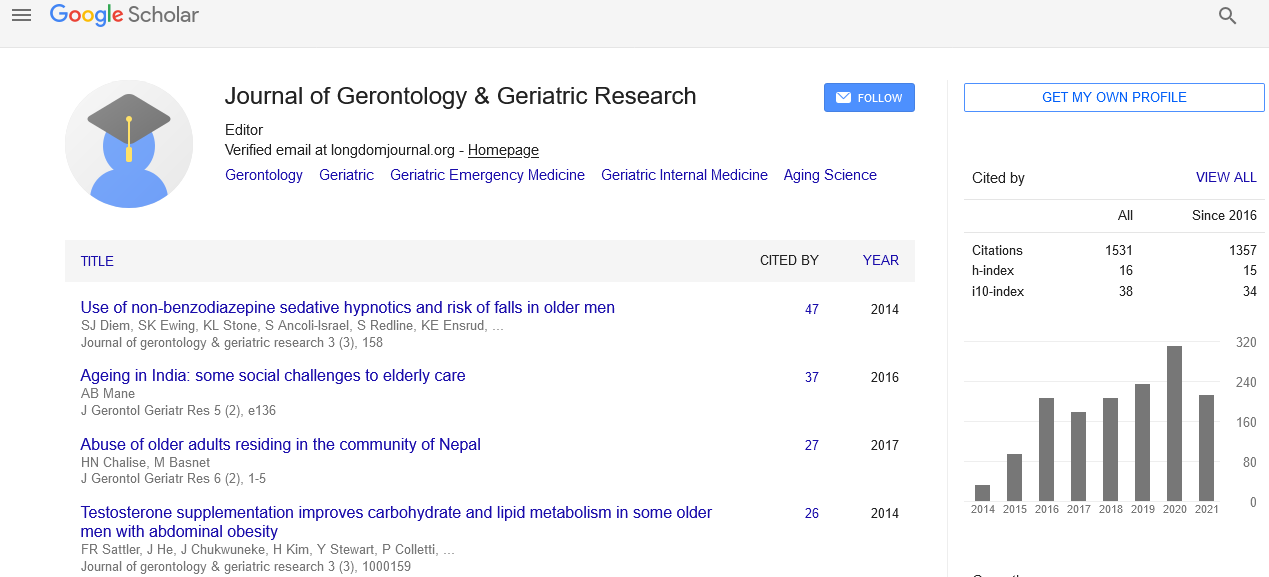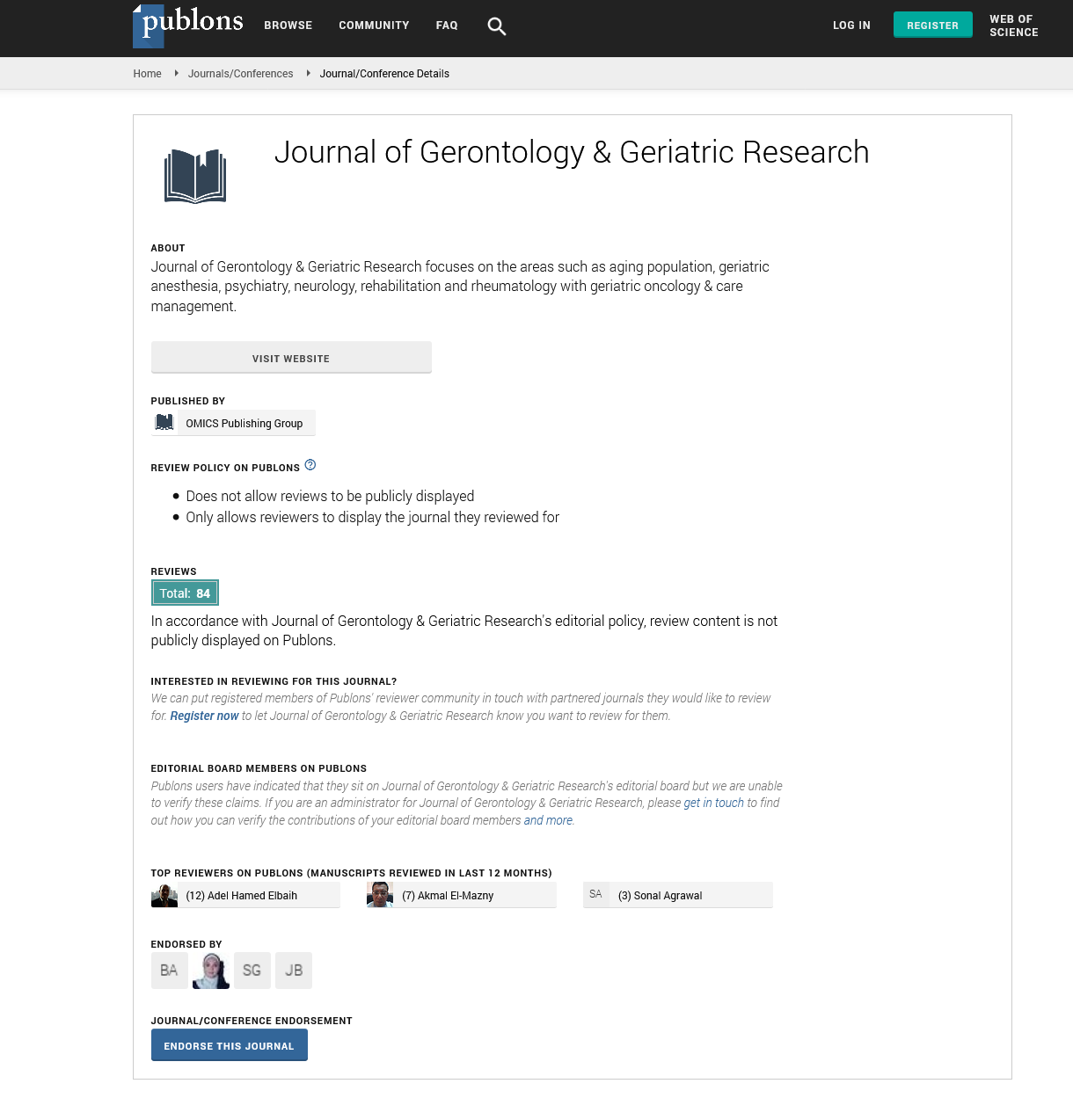PMC/PubMed Indexed Articles
Indexed In
- Open J Gate
- Genamics JournalSeek
- SafetyLit
- RefSeek
- Hamdard University
- EBSCO A-Z
- OCLC- WorldCat
- Publons
- Geneva Foundation for Medical Education and Research
- Euro Pub
- Google Scholar
Useful Links
Share This Page
Journal Flyer

Open Access Journals
- Agri and Aquaculture
- Biochemistry
- Bioinformatics & Systems Biology
- Business & Management
- Chemistry
- Clinical Sciences
- Engineering
- Food & Nutrition
- General Science
- Genetics & Molecular Biology
- Immunology & Microbiology
- Medical Sciences
- Neuroscience & Psychology
- Nursing & Health Care
- Pharmaceutical Sciences
Editorial - (2021) Volume 10, Issue 6
Editorial Note on Glycation End Products and their Receptors in Patients with Type 2 Diabetes
Suresh Babu G*Received: 19-Jun-2021 Published: 29-Jun-2021, DOI: 10.35248/2167-7182.21.10.557
Editorial
Numerous non-enzymatic chemical reactions known as glycation occur during heat treatment operations and extended food preservation. They also happen in living organisms when reducing sugars like glucose or fructose interact with amino acids, peptides, or proteins that contain free amino groups. Glycation happens between sugars and phospholipids or nucleic acids to a lesser extent.
Glycation occurs in biological systems in two stages: initial and final (advanced). The reversible reaction of an electrophilic carbonyl group or hemiacetal reducing sugar with the free amino group of amino acids is the initial stage of glycation (most commonly lysine and arginine). The creation of a covalent bond and the removal of water are the consequences of the reaction. The end outcome is a Schiff base that is unstable (imine). This reaction is quite quick, and the equilibrium is reached in a few of hours. It's also worth noting that different carbohydrates react differently with the amino groups of peptides or proteins. For example, fructose, which is frequently used as a glucose supplement by diabetics, is more reactive in vitro than glucose. Monosaccharides and dicarbonyls are the most common glycation substrates, although glycation products based on the disaccharide melobiose have recently been identified. Carbohydrates prefer to react with lysine (forming N—carboxymethyllysine), while dicarbons prefer to react with arginine. The Schiff base then undergoes an intramolecular rearrangement known as the Amadori reaction, which produces ketoamine: 1-amino-1-deoxyketose, a more stable and partially reversible early glycation product.
Classic Amadori reaction products are changed into a material with a distinctive brownish-yellow colour when exposed to oxygen. Glycooxidation is a term used to describe these alterations. Schiff base and Amadori products can form protein adducts or cross-linked proteins by irreversibly reacting with amino acid residues in proteins or peptides. Alternatively, these compounds can go through more Maillard reactions such oxidation, dehydration, polymerization, and a variety of other transformations that result in the creation of several reactive oxygen species (ROS) or dicabonyl compounds (glyoxal, methylglyoxal, ethylglyoxal, 3-deoxyglucosone). The compounds that result from this process are extremely reactive. As a result, they react with protein amino groups, resulting in the creation of advanced glycation end products (AGEs). Adjacent AGE molecules can form cross-links with each other and with specific proteins, interfering with the function of cells and tissues throughout the body. The frequency of AGEs is one cross-link every several hundred molecules. After laser irradiation with a length of 300–420 nm, the ultimate glycation end products emit light in the range of 420–600 nm.
Glycation products have a wide range of effects, involve many pathways, and utilise a variety of receptors. AGEs bind to particular receptors on the surface of phagocytes and endothelial cells, among other cells. For advanced glycation end products, there are a few different types of receptors.
Citation: Suresh Babu G (2021) Editorial Note on Glycation End Products and their Receptors in Patients with Type 2 Diabetes. J Gerontol Geriatr Res. 10: 557
Copyright: © 2021 Suresh Babu G. This is an open-access article distributed under the terms of the Creative Commons Attribution License, which permits unrestricted use, distribution, and reproduction in any medium, provided the original author and source are credited.


